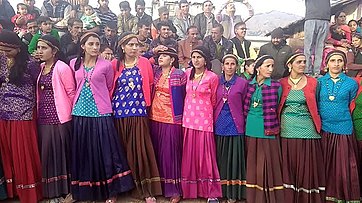|
Jaunsari people
The Jaunsari are a small community found in Uttarakhand, northern India, more specifically in the Jaunsar-Bawar region of the western portion of the state in Garhwal Division. They speak the Jaunsari language which is an Indo-Aryan language.[2] CultureJaunsari community reveres ‘Mahasu Devta’ which is principal deity of Jaunsari community. Dance and music are integral part of Jaunsari culture. During festivals both men and women dance under the intoxication of the folk music. Local people perform folk dances such as Harul, Ghundiya Raso, Jhenta Raso, Jangbazi, Thoude, and many more.[3][4] Fair like Moroj and Bissu are held which mark the harvesting period.[5]   ClothingAs a society which resides in the harsh climate of the Himalayas, their clothing is primarily woollen oriented which would keep them warm. Their attire stands out from the rest of Uttarakhand. Men's Clothing: Jaunsari men wear a woolen pyjama known as Jhangel (झंगेल) and on top of that they wear a woollen robe known as Chora (चोड़ा), both made up of sheep wool. The Chora's texture is that of a karate uniform, it can be kept loose, or it can be tucked in both of the sides and can be bound at the waist with a woollen belt known as Manjan (मँजण). It can also be draped over the shoulders without tucking in the arms. As for headwear, traditionally men have been wearing Diguwa (डिगुवा) or popularly known as Gandhi Cap for a very long time, but in modern fashion men can be seen sporting a Himachali cap. During winters when it snows a lot people wear woollen shoes known as Khurshe (खुर्शे) which keeps the wearer's feet warm. Judo (जुडो) is a local variation of the Jama (coat) which was popular during early modern times. It covers the entire body like a gown, it reaches just above the ankles and has folds. The sleeves, shoulders, chest and back portion of the dress are embroidered whereas the rest of the region remains white. It is accompanied by a cotton/silk Manjan (मँजण), i.e., a belt. It was to be worn by everyone attending the darbar of the Sirmaur King in its capital Nahan in old times. Nowadays, it is worn during festivals for performing folk dances. Women's Clothing: Jaunsari women wear 'Ghagra' which is usually a 6 to 7 meters long piece of cloth, stitched together to form a long skirt, it's unique due to its sharp folds/pleats known as Luria (लुड़िया), such a texture is achieved by heat-pleating the folds. The portion which divides the Ghagra from the fall of the Ghagra is embroidered with floral patterns which forms a strip which is known as Phita (फिता). The Ghagra is paired with a Jhagga (झग्गा) which is Jaunsari for Kameez. It can be paired with a Waistcoat or it can be paired with a Kurti (कुर्ति) - which is an overcoat especially made for women. Women's version of Chora is known as Cholori (चोलोड़ी). Women cover their head with a scarf known as Dhantu (ढाँटु) which can be tied in various styles. For jewellery women wear Tungal (तुंगल), Bulak (बुलाक), Nath (नाथ), Utraiyan (उतरैइयाँ), etc. A smaller Ghagra for younger girls is known as Ghaguti (घागुटि). References
|
||||||||||||||||||||||||
